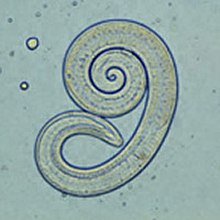Trichinella spiralis
| Trichinella spiralis | |
|---|---|
 |
|
| Scientific classification | |
| Kingdom: | Animalia |
| Phylum: | Nematoda |
| Class: | Adenophorea |
| Order: | Trichocephalida |
| Superfamily: | Trichinelloidea |
| Genus: | Trichinella |
| Species: | T. spiralis |
| Binomial name | |
|
Trichinella spiralis (Owen, 1835) |
|
Trichinella spiralis is an ovoviviparousnematode parasite, occurring in rodents, pigs, horses, bears, and humans, and is responsible for the disease trichinosis. It is sometimes referred to as the "pork worm" due to it being typically encountered in undercooked pork products.
Trichinella species, the smallest nematode parasite of humans, have an unusual lifecycle, and are one of the most widespread and clinically important parasites in the world. The small adult worms mature in the small intestine of a definitive host, such as a pig. Each adult female produces batches of live larvae, which bore through the intestinal wall, enter the blood (to feed on it) and lymphatic system, and are carried to striated muscle. Once in the muscle, they encyst, or become enclosed in a capsule. Humans can become infected by eating infected pork, horsemeat, or wild carnivores such as fox, cat, or bear.
Males of T. spiralis measure between 1.4 and 1.6 mm long, and are more flat anteriorly than posteriorly. The anus can be found in the terminal end, and they have a large copulatory pseudobursa on each side. The females of T. spiralis are about twice the size of the males, and have an anus found terminally. The vulva is located near the esophagus. The single uterus of the female is filled with developing eggs in the posterior portion, while the anterior portion contains the fully developed juveniles.
Trichinella spiralis can live the majority of its adult life in the intestines of humans. To begin its life cycle, "Trichinella spiralis" adults will invade the intestinal wall of a pig, and produce larvae that invade the pig's muscles [14]. The larval forms are encapsulated as a small cystic structure within a muscle cell of the infected host. When another animal (perhaps a human) eats the infected meat, the larvae are released from the nurse cells in the meat (due to stomach pH), and migrate to the intestine, where they burrow into the intestinal mucosa, mature, and reproduce. Juveniles within nurse cells have an anaerobic or facultative anaerobic metabolism, but when they become activated, they adopt the aerobic metabolism characteristics of the adult.
Female Trichinella worms live for about six weeks, and in that time can produce up to 1,500 larvae; when a spent female dies, she passes out of the host. The larvae gain access to the circulation and migrate around the body of the host, in search of a muscle cell in which to encyst . The migration and encystment of larvae can cause fever and pain, brought on by the host inflammatory response. In some cases, accidental migration to specific organ tissues can cause myocarditis and encephalitis that can result in death.
...
Wikipedia
